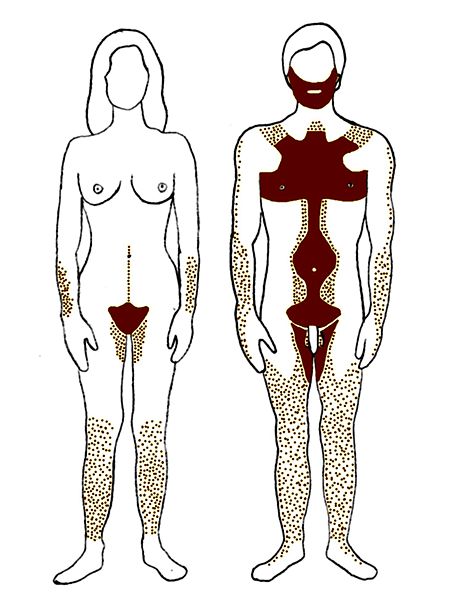Androgenic hair

Template:Human hair Androgenic hair, colloquially Body hair, is the terminal hair on the human body developed during and after puberty. It is differentiated from the head hair and less visible vellus hair. Androgenic denotes its growth is related to the level of androgens (male hormones) in the individual. Due to a normally higher level of androgens, men tend to have more androgenic hair than women.
From childhood onward, regardless of sex, vellus hair covers the entire human body. Exceptions include the lips, the backs of the ears, the palms of hands, the soles of the feet, certain external genital areas, the navel and scar tissue. The density of hair (hair follicles per square centimeter) varies from one person to another.
Development and growth
Rising levels of androgens during puberty cause vellus hair to transform into terminal hair over many areas of the body. Hair follicles respond to androgens, primarily testosterone and its derivatives. Different areas respond with different sensitivities. The rate of hair growth and the weight of the hairs increase. The sequence of appearance of androgenic hair reflects the gradations of androgen sensitivity. Since the pubic area is most sensitive, heavier hair usually grows there first. Generic factors determine individual levels of androgens and thus hair development.

Most noticeable in both sexes are the development of axillary hair and pubic hair. Thus it is sometimes viewed as a secondary sex characteristic. There is a sexual differentiation in the amount and distribution of androgenic hair, with males having more terminal hair in more areas. This includes facial hair, chest hair, abdominal hair, leg and arm hair. Females retain more of the less visible vellus hair, though leg and arm hair is noticiable.
Evolution
Evolutionary and genetic evidence suggests human androgenic hair is the remnant of body hair of the type found on today's great apes. Full-on body hair phased out in the course of human evolution roughly 2-3 million years ago. Loss of body hair is related to several unique aspects of human evolution. Homo Erectus, and later pre-modern humans, began relying on sweating for thermoregulation instead of insulating hair. Because of the intensity of sunlight, and harmful ultraviolet radiation, loss of hair put positive selective pressures on development of protective dark skin colour. Based on the numbers and spread of variations in the MC1R nucleotide sequences between humans and chimpanzees, modern hair patterns were seen by 1.2 million years ago. However, hair densities and patterns on humans differ for populations in differing climes.